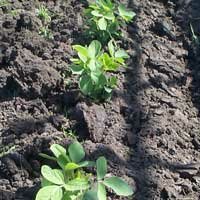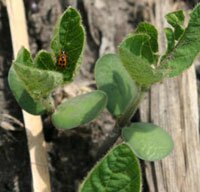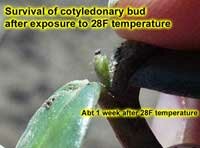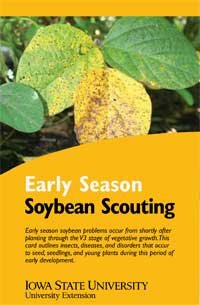
- Agronomics
-
Diseases
- Asian Rust
- Anthracnose
- Bacterial Blight
- Bacterial Pustule
- Bean Pod Mottle Virus
- Brown Stem Rot
- Cercospora Leaf Blight
- Charcoal Rot
- Downy Mildew
- Frogeye Leaf Spot
- Green Stem Syndrome
- Iron Deficiency Chlorosis
- Phytophthora Root & Stem Rot
- Powdery Mildew
- Rhizoctonia
- Seedling Diseases
- Septoria (Brown Spot)
- SCN (Soybean Cyst Nematode)
- Soybean Mosaic Virus
- Stem Canker
- Sudden Death Syndrome
- Viruses
- White Mold
- Pests
- Biological Control
- Diagnostic Tools
- About Us
- Library


Your soybean checkoff.
Delivering Results.
Early Season Scouting
 |
| Monitoring crop performance tells you how well your management practices are working. Photo: University of Illinois |
The case for scouting
Accurately predicting pest and disease outbreaks is never easy, but this year's unusual weather patterns will make it even more challenging. The importance of scouting has never been greater.
Scouting fields regularly -- ideally every 7 to 10 days -- makes it possible to catch problems early, when it's much easier to figure out what happened, and to respond. Take advantage of the many excellent resources and information available to help you.
Guidelines for early season scouting - VE to V3
Take stand counts
At this stage, 120,000 to 140,000 plants are generally recommended, aiming for a population of 100,000 plants at harvest.
 |
| Seedlings can usually recover from bean leaf beetle feeding — use thresholds and extent of injury to plant growing tips to determine if treatments or replanting is needed. Photo credit: Erin Hodgson, Iowa State University Integrated Crop Management News |
Look for bean leaf beetles
As soybeans emerge, the beetles move from legumes to soybeans and can cause considerable defoliation of young seedlings. Fields planted earliest in an area are most at risk for high beetle populations.
Bean leaf beetles are the main vector of the Bean pod mottle virus. Areas of early heavy feeding by the bean leaf beetle are the most likely areas for virus disease to develop later in the season.
Investigate areas of poor stand establishment
Check for signs of seed and seedling-infecting fungi (damping off). Plant pathologists at Iowa State University have found that Pythium, Phytophthora, and Rhizoctonia account for nearly 90 percent of disease-related stand reduction problems in Iowa.
White grubs and/or seedcorn maggots may be responsible for gaps in rows and/ or for wilted or dead seedlings. Dig up plants in the affected area. Look for white grubs in the root zone and examine the root system for pruning. Check ungerminated seed for injury and presence of seedcorn maggots.
 |
| Soybean will recover from frost damage if any axillary buds in the leaf axils are alive. Click on image to view a larger version. Photo credit: Purdue University |
Assess frost damage
Frost damage can look very serious the day after the event, but recovery may be possible if the growing points are not damaged. You will need to wait three to five days after the weather event before you can accurately assess the extent of damage or recovery.
Identify the weed species present
With increased adoption of total postemergence programs, it's even more important to recognize weed management issues soon after crop emergence. Accurate identification can be tricky when plants are young, but at this stage they are much easier to control.
Herbicide injury is much easier to identify and diagnose early in the season, soon after occurance. It frequently occurs in distinct patterns within a field.
 |
Resources for early season scouting
Early season scouting - Iowa State University (pdf)
Mild Winter, Record-Breaking March Temperatures: How Will Field Crop Insects Respond? Mike Gray, Extension entomologist at the University of Illinois, notes migratory and non-migratory insect species are affected differently by our winter and early spring weather.
Early Season Frost and Low Temperature Damage to Corn and Soybeans - Purdue Univerisity (pdf)
A Quick Guide to Herbicide Injury of Soybean - Illinois Soybean Association, University of Illinois Extension
Herbicide Mode of Action Key for Injury Symptoms - Integrated Pest Management Program, University of Wisconsin
Weed Emergence Sequence: knowledge to guide scouting and control (poster) - Iowa State University (pdf)
Identifying Early Season Weeds - The Bulletin, University of Illinois